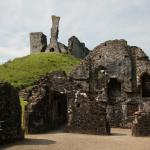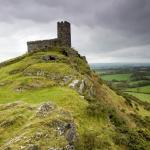Ghosts in Devon
With its often dramatic coastline and the bleak, formidable interior of Dartmoor, Devon is host to any number of myths and legends. From the satanic hell-hounds that inspired Conan Doyle's "Hound of the Baskervilles" to a cheeky chap who like to pinch ladies' behinds there are plenty of tales of ghosts and ghouls. In this article I have looked at some of Devon's spookiest places and picked ten haunted hotspots.
Saltram
Saltram is one of the finest houses in Devon. Situated overlooking the River Plym near Plymouth this Georgian manor house is lavishly decorated and some might say even a little ostentatious. Along with paintings by Joshua Reynolds there is finely crafted plasterwork, hand-painted Chinese wallpaper and period ceramics.
The house is built on, and incorporates parts of, a previous tudor house. Whilst long gone, echoes of this past, and more recent, are said to haunt the rooms and passages of this old house.
Of all the ghosts that roam Saltram the best known is that of a kitchen maid. It is not known why or when she died but it is said she was murdered, although no one was ever brought to justice. Those who have seen her have described a hooded figure in a dark cloak that glides across the corridor before passing through the door which leads into the dining room. However, she never appears on the other side of the door.
Another of Saltram's ghosts is that of a child who has reputedly been seen sitting at the foot of guests beds only to disappear soon after.
Buckland Abbey
This fine medieval house near Yelverton was once (as the name suggests) an abbey. As with all of England's abbeys Buckland was shut down by Henry VIII in the 1540s. Fortunately Buckland Abbey did not suffer the fate of many of these fine buildings and was sold into private hands.
The first owner was a Sir Richard Grenville and his son Roger. However, Roger was aboard Henry VIII's ill-fated Mary Rose when it sank of Portsmouth. In 1582 the house was sold on by Roger's son, Richard, to an unknown buyer. This turned out to be Sir Francis Drake whom Sir Richard despised.
Legend states that Drake finished converting the abbey to his residence in a mere three days. He managed to do this with help from the Devil. As punishment for his satanic dabblings Drake was condemned to ride in a hearse, pulled by headless horses, across Dartmoor on wild nights followed by a pack of demonic hounds.
It is also said that the soul of Drake is contained within a drum that is on display inside the abbey. Apparently he gave instructions for the drum to be returned to his home as he lay dying on his ship, the Puerto Bello in 1596. The legend is that if ever England is in danger then the drum will be heard to beat. The last time it was heard was in 1939...
Berry Pomeroy Castle
The dramatic ruins of Berry Pomeroy Castle, near Totnes, have an equally drama-filled history. From the Norman Conquest on this was the home of the powerful Pomeroy family, although the ruined castle only dates back to the 15th century.
Probably the most colourful legend from Berry Pomeroy is that of the two Pomeroy brothers. After the failed "Prayer Book Rebellion" of 1549 which the Pomeroys had supported, the King, Edward VI, ordered that the castle's defences should be reduced. The Pomeroys refused so Henry sent troops. When they arrived they were met by the brothers in full armour. The brothers were on the castle's battlements on the backs of their horses which they had blindfolded. To the astonishment of the soldiers the Pomeroy brothers proceeded to ride off the top of the castle to their deaths.
Another dark tale from Berry Pomeroy is that of the sisters Eleanor and Margaret Pomeroy. It is said that they both fell in love with the same man. Whilst Margaret was beautiful Eleanor was equally jealous and imprisoned here sister, starving her to death. Margaret's ghost walks the castle ramparts and it is said that anyone who sees here will meet their death soon after.
Berry Pomeroy has another ghost; a blue lady. The story is that she was one of the Pomeroys and was involved in an incestuous relationship with her father. After falling pregnant she smothered the baby at birth. Because of this act she has been condemned to wander the castle for eternity. Again , it is said seeing this ghosts portends death.
Dartmoor
Where to begin? I could have devoted this whole article to the hauntings of Dartmoor. Given the number of tormented souls that wander this bleak and wild moor it is seems the most likely place of bumping into a ghost anywhere in Devon.
One of the best known, and strangest of all Dartmoor's hauntings is that of the "Hairy Hands". These are said to haunt the main B3212 road across the moor between Postbridge and Two Bridges.
On a bright summer's day of June 1921 the story goes that the medical officer of nearby Dartmoor Prison, Dr Helby, was riding his motorbike along this stretch of road. By the famous clapper bridge at Postbridge he swerved for no apparent reason and ended up dead. Some time after this first accident an army officer was involved in a similar accident in the same place. He survived and was able to give a bizarre and shocking version of events. He said that a pair of large, extremely hairy hands had grabbed onto his own hands and forced him to swerve and crash.
Over the following years there were a couple of unexplained crashes on this stretch of road with the most recent a doctor from Somerset who overturned his car here. Like the others he claimed an external force had tried to take control of the car.
One particularly disturbing incident occurred at the ruins of the old powder mills nearby. The Brown family would park up their caravan here for a month every summer. One night one of the occupants was woken by a sound coming from the open window. When she looked to see what it was, to here terror she saw a large hairy hand crawling up the window towards the gap. After she made the sign of the cross and prayed it seems the haunted hand slunk away.
Plymouth
Devon's largest city has a rich maritime heritage. Whilst much of the city centre was destroyed and rebuilt following World War II the old harbour district of the Barbican has survived reasonably well over the centuries. With a colourful history history it is no surprise that this part of the city is a veritable hive of paranormal activity.
Located on News Stret, one of Plymouth's oldest surviving buildings is the 16th century Elizabethan House which was once home to a sea captain. Now open to the public the house remains home to the ghost of a young servant girl. Witnesses have seen her standing at an upstairs window at various times of the day and night. The house is also reported to have cold spots and furniture has been heard moving around.
The nearby Blackfriar's Distillery is home to the Plymouth Gin Distillery these days. Set on the Barbican's main street there have been many a ghost sighting here. One of these is the ghost of a former worker named 'Charles' who by all accounts he is prone to pinching ladies' bottoms.
Buckfastleigh
The small market town of Buckfastleigh sits on the eastern edge of Dartmoor. On a lonely hill above the town lies the town's church and within the churchyard, the strange tomb of Squire Richard Cabell.
Looking more like a bus shelter than a mausoleum, the tomb's design was purely functional, being constructed by locals to contain Cabell's unquiet spirit. When Cabell died in 1677 many believed he had been in league with the Devil. The legend is that on the night before his death a ghostly pack of hounds descended from the moor to escort Cabell's soul down to hell.
Not only does the tomb have strong iron bars but Cabell's coffin was placed under a large solid rock to be certain he could not escape. However, it seems all these precautions were in vain as it is said that on wild and windy nights the pack of ghostly hounds come for Cabell and together they go hunting on the moors.
It is thought that this story was one of Sir Arthur Conan Doyle's main inspirations for his best known work - The Hound of the Baskerville's.
As if all this was not enough to assure Buckfastleigh churchyard's place on the list of Devon's most haunted, further misfortune befell the place. On the night of the 21st July 1992 the church here was burnt down in an act of arson leaving only the burnt-out shell that remains to this day. The culprit was never found and some believe it may have been the work of Satanists drawn to the place by the presence of Squire Cabell's tomb.
Powderham Castle
It would be a rare thing to find a historic house that didn't have at least one ghost. The bigger, older and more historic the more likely it seems, and Powderham Castle is all these. Dating back to the 14th century this fortified manor house near Exeter was much extended and altered during the 18th and 19th centuries.
It was during some of this construction work during the 19th century that a grim discovery was made. After breaking down a wall they discovered a hidden chamber within which were the skeletons of a woman and infant. This went some way to explaining the ghost of a young mother and child that had been seen around the house for many years. However, still non-the-wiser as to who the mother and child were and how they came to be there, the owners of the house gave the two a proper burial at nearby Powderham church. This was partly in the hope that it might lay their souls to rest although this is not what seems to have happened as the ghosts carry on to roam the corridors of the house to this day.
Another sinister apparition that haunts Powderham is a "grey lady" who has on occasion been floating between the church and house or haunting the library. It is believed that this melancholy spirit is that of Lady Frances, the wife of the 18th century Viscount Courtenay. Legend has it that seeing the ghost of Lady Frances is a bad omen.
Exeter
The historic city of Exeter is another hotspot for all things paranormal. With parts of the city inhabited as far back as Roman times it has had many years to develop a healthy population of ghosts.
Whilst many of Exeter's old buildings are rumoured to be haunted it seems that the history loving ghosts have chosen the area around the medieval cathedral to congregate. This is probably no coincidence as during the 17th century the Cathedral Green was the city's main graveyard. In those days bodies were buried 10 deep and the level of the green rose to the height of the cathedral windows in order to accommodate the dead.
All manner of apparitions have been seen roaming the immediate area from a disembodied hand through to a three-headed phantom. The cathedral itself is said to be home to a number of ghosts the most commonly seen of which is that of a nun who haunts the nave, particularly in the early evening. Another of the cathedral's well-known ghosts is that of Walter Lechlade, a 13th century choir master. Described as a "dishonest and unpleasant" man he was murdered on the Green. His charmless ghost has been observed in the top vestry.
Another place on the Cathedral Yard that is said to be haunted is the Royal Clarence Hotel. Dating back to 1769 it is credited as being the first hotel in England however, the building was tragically destroyed by fire in 2016. It was built on the site of Sir Walter Raleigh's and guests have reported hearing the sound of coughing. Whether the haunting will be continued when the hotel is rebuilt is unknown.
Okehampton Castle
It is said that Lady Frances Howard poisoned her four husbands. Indeed the story goes that she was twice widowed by the age of 16.
As punishment for her prolific murderous streak Lady Howard was condemned in the afterlife to a miserable, if not eternal task. Every night she has been compelled to pluck a single blade of grass from the slopes of Okehampton Castle - something she must do until the hillside is bare. Given she died in the 16th century and the healthy covering of grass some 500 years on things aren't looking too rosy for Lady Howard.
The legend is that every night Lady Howard rides with a macabre cortege from her family home at Fitzford Gate in Tavistock across the moors to Okehampton. At the head of the procession is a great black hound with one eye in the middle of its forehead. Lady Howard herself rides in a coach made of the bones of her four husbands and this is drawn by headless horses.
The reality of Frances Howard's life was probably actually somewhat different to her vilified memory. It seems she was married off at the age of 12 for her money after her wealthy father killed himself. After three such marriages she eventually eloped with the man she loved, but he died tragically shortly afterwards. Lady Howard decided to live out her days at Fitzford Gate with her beloved son George. But tragedy struck again and he too died, followed by Lady Howard a month later.
Chambercombe Manor
The medieval manor of Chambercombe near Ilfracombe dates back as far as the 12th century and is well known for its hauntings. For hundreds of years it was the seat of various titled lords and ladies with illustrious visitors such as Lady Jane Grey. However, at some point in history it fell from grace and spent many years as a glorified farmhouse.
During renovation work in 1865 the then owners noticed something strange. There were traces of an upstairs window, but no corresponding room. Guessing it was next to one of the bedrooms they knocked through the wall and found a concealed chamber. In this room was a four-poster bed with the skeleton of a young women in it. Who she was remains something of a mystery although there tragic legend.
It is said that in the 18th century William Oatway and his Spanish wife were tenants in at Chambercombe. They had a daughter, Kate, who over the years grew into a beautiful young woman. Kate fell in love with an Irish captain named Wallace, whom she married and moved away to Dublin, promising to one day return and visit.
Some years passed until one night there was a terrific storm and a ship was washed onto the rocks nearby. William went down to the wreck to look for survivors and found a horribly wounded young woman who had been battered beyond recognition on the rocks. He carried the woman home where he and his wife tried in vain to save her.
The couple searched the body to try and find something that would identify the woman. What they did find was a purse containing a small fortune in precious jewels and gold coins. The couple couldn't resist the temptation to take the purse as it was enough to see them through to the end of their days.
A day or so later there was a knock at the door and an agent from the shipping company stood there, enquiring about a young woman who was missing from the wrecked ship. The couple said they didn't know anything about here whereupon the agent left asking if they could keep a lookout for the body of a Katherine Wallace, should it wash up. William and his wife realised they had robbed the body of their dead daughter and were obviously devastated. He placed the body in a bed and bricked off the secret chamber where the body lay undiscovered for over a hundred years.
To this day the ghost of Kate Wallace is said to roam the corridors of Chambercombe Manor and a moaning sound has been heard coming from where the secret chamber was constructed.















